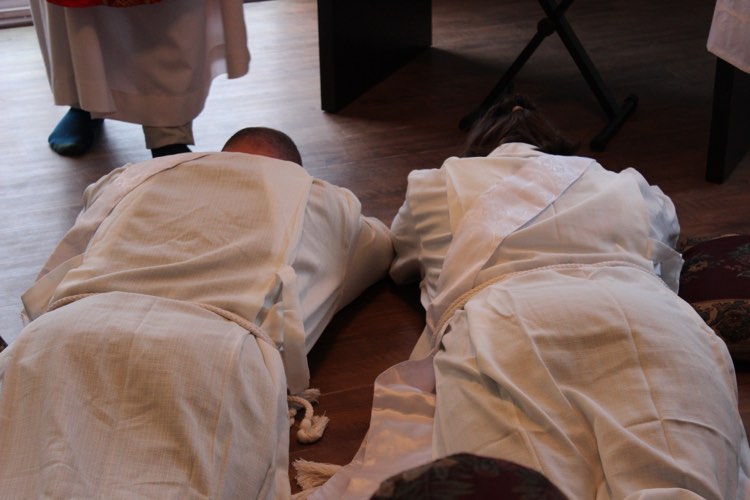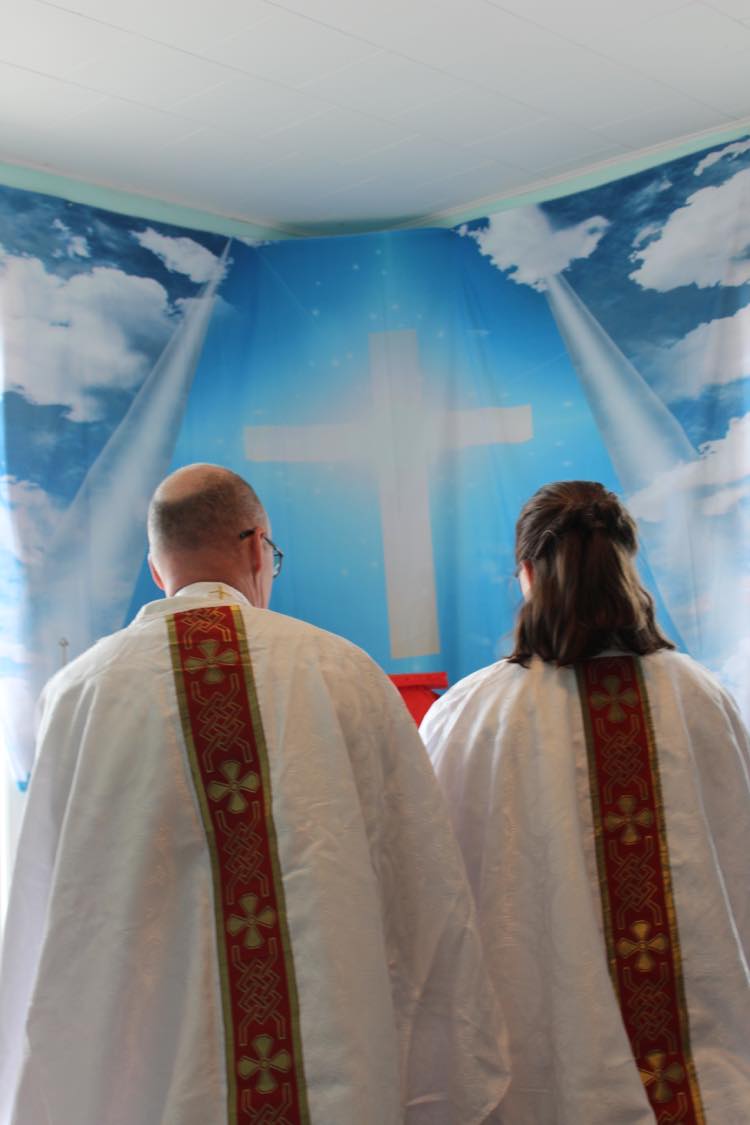- Home
- simply catholic
- Catholic Sacraments
- Catholic Mass
Simply Catholic and Welcoming You
Catholic Mass and the Holy Eucharist: An in depth explanation
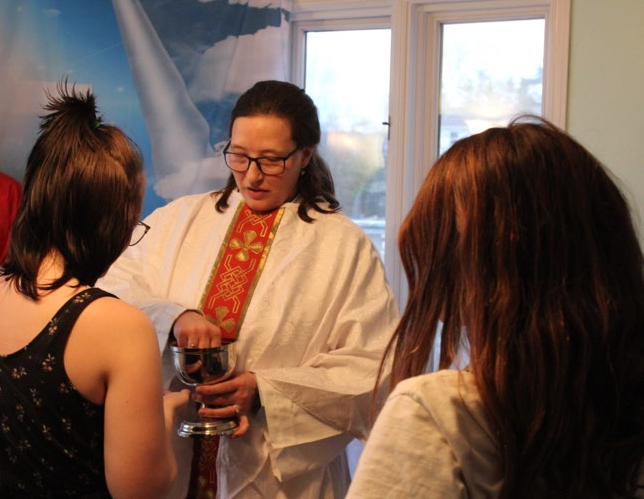
The Sacrament of the Eucharist called "The Sacrament of Sacraments"
The Sacrament of the Eucharist
The sacrament of the Eucharist is when Christians remember the Last Supper and the command of Jesus to ‘..do this in remembrance of me’. The Eucharist is referred to by many Catholics as Mass and it involves spiritually feeding participants with the body and blood of Christ.
Eucharist here refers to Holy Communion or the Body and Blood of Christ, which is consumed during the Catholic Mass or Eucharistic Celebration. The Eucharist is upheld as the Sacrament of Sacraments and all the other Sacraments lead to it as it was this sacrifice that made salvation possible for us all.
The transformed bread and wine are truly the Body and Blood of Christ and are not merely symbols. When Christ said “This is my body” and “This is my blood” the bread and wine are transubstantiated. Though the bread and wine appear the same to our human faculties, they are actually the real body and blood of Jesus.
Catholic Mass here refers to the ritual of chants, readings, prayers, and other ceremonies used in the celebration of the Eucharist in the Catholic churches.
The Mass is the central liturgical rite in the Catholic Church, encompassing the Liturgy of the Word (Mass of the Catechumens) and the Liturgy of the Eucharist (Mass of the Faithful), where the bread and wine are consecrated and become the Body and Blood of Christ.
The Church describes the Catholic Mass as the "source and summit of the Christian life". We see the Eucharist as a sacrifice. We believe that the sacramental bread and wine, through consecration by an ordained priest, become the sacrificial body, blood, soul, and divinity of Christ as the sacrifice on Calvary made truly present once again on the altar.
We also believe that at the moment of consecration it is Christ, through the priest who consecrates the Eucharist.
Now, let’s deal with the question of ‘First Communion’.
At St. Brigit’s we take the position that children are innocents and Jesus said "Suffer little children to come unto me, and forbid them not: for of such is the kingdom of God. Verily I say unto you, Whosoever shall not receive the kingdom of God as a little child shall in no wise enter therein." Matthew 19:14
Thus, for us any child under 11 years of age, regardless of their baptismal status may freely receive the Eucharist (provided they can do so respectfully). Likewise any baptized christian over 11 years old may join us in the celebration of the Eucharist and freely partake of it, regardless of their church of origin or current denomination.
Please understand, we do not dispute how other people or other, even related, religions see things nor the decisions they make concerning the practice of their faith. We simply claim the right to practice our faith as we uniquely see fit and acknowledge that we, therefore, must extend that same courtesy and right to others in turn.
Background
On the road to Emmaus (Luke 24:13-35) the as yet undisclosed or unrecognised Christ, discusses and explains the scriptures to the two travellers.
They invite Him to their home and it is not until the Breaking of the Bread that Christ is revealed and known to them.
Catholic Mass essentially takes us on this same ‘journey’. Opening with greetings, proceeding to the scriptures and conversation (the very meaning of the word homily) and then, in the Breaking of the Bread Christ’s presence is revealed and known to His believers.
Christ rose from the dead on Sunday, thus Sunday is now the Lord’s Day. Shifting it from the Jewish Sabbath of Saturday. This has been the practice of Christians since A.D. 150-175.
Further, liturgy meant "public work" and now means "public worship".
Even the "formality" of catholic mass stems from the formality of the Jewish Paschal meal, which to us has become known as The Last Supper. Where Jesus Himself taught us to "break bread" taking the bread as His body and the wine as His blood and to do so ‘’in remembrance of me’’.
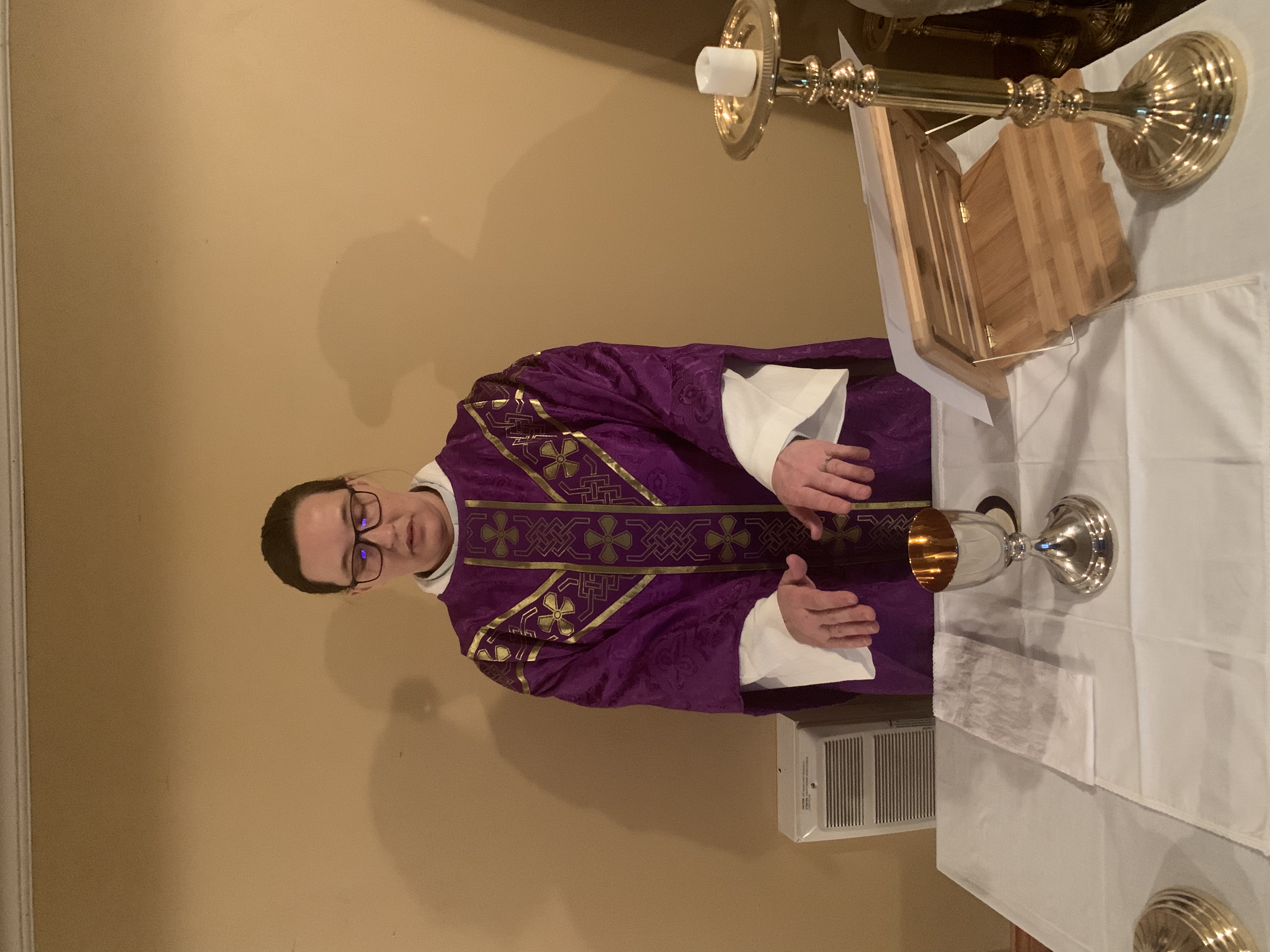
Purple vestments for Lenten season
Catholic Mass: Vestment Colors and Their Meanings (in terms of Liturgy)
Green - Worn in Ordinary time and symbolising growth and life
Red - Worn on Feasts of the Lord’s Passion, martyrs and Pentecost and symbolising sacrifice and the Holy Spirit
White - Worn on the feasts of the joyful mysteries of Jesus, Mary, the Angels and saints, symbolising Innocence, Purity, Victory and Joy
Black - Worn during Masses for the dead and symbolising death and mourning. Often purple is used for this as well as for Lent or for any Penitential Rite with black then being reserved for military, first responder or person of state funerals.
Marian Blue - Worn during all feast days of the Virgin Mary. These became ‘popular’ when worn by pope Benedict XVI in Austria in 2007. Still not recognised as an official liturgical colour by the Roman Catholic church but worn by ‘special permissions’ on occasions. It is an accepted colour for Catholics in the Byzantine and Syrian churches and in St. Brigit’s Community Catholic Church.
Entire books have been written to explain every detail of the Mass in exhausting detail. Of interest to priests and scholars but entirely too much for general reading.
My intent is to simply provide basic details of the various parts and symbolism of the Catholic Mass to assist those who seek a better understanding of what this wonderful celebration is about. Hopefully giving greater enjoyment of their experience when they choose to attend and helping them to participate more fully.
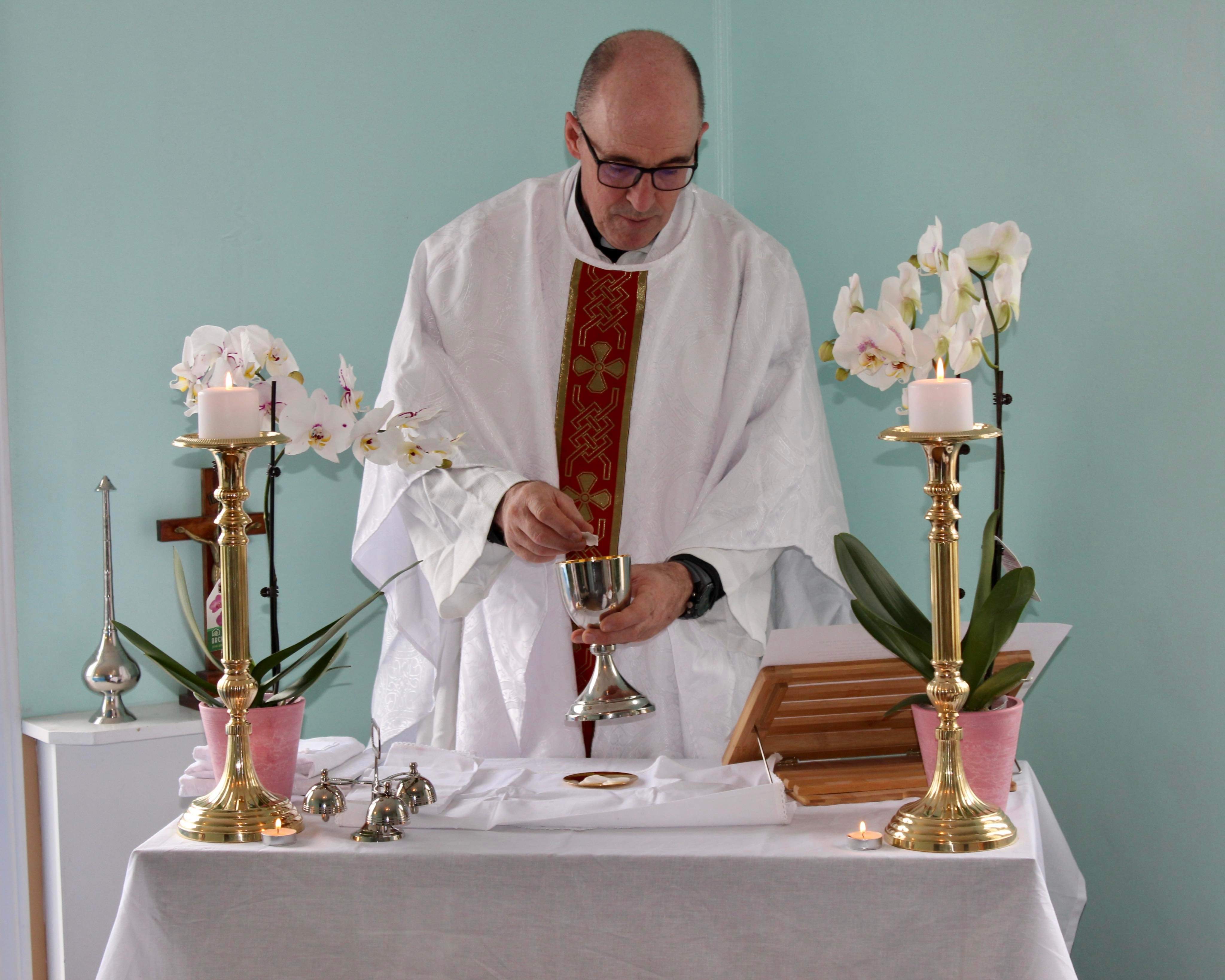
Easter mass consecrating the Eucharist
Understanding the Roman Rite Catholic Mass
Catholic mass Opens with the priest and altar servers (plus deacons if present) following the cross through the church to the altar.
This is a reminder of Jesus telling us to take up our cross and follow Him and to symbolise that we follow the crucified and risen Christ.
Priests genuflect to the Tabernacle a repository for ‘reserve hosts’ (Communion wafers left over from previous Masses) as ‘soldiers of Christ bowing to our Lord’. When there is no tabernacle we bow to the cross.
When the priest is in position at the altar they kiss the altar, a symbol of Christ's cross, the ‘altar’ upon which He was sacrificed for us and where we will now re-enact that sacrifice.
Many churches also have a saint’s relic secured in the altar so kissing it also shows respect and veneration for that saint.
A procession hymn plays throughout the procession in a tradition long established as ‘sing to the Lord’. Viewed as a higher form of prayer.
All now make the sign of the cross which invokes Christ and marks us as His.
Next an invitation to recall our sins
Followed by a Prayer of Contrition
Then General Absolution
These all stem from the tradition of not approaching the Lord unworthily. We acknowledge that it is only by God’s mercy that we become worthy to receive His sacraments.
Next we say the Gloria which can also be chanted and/or sung on special occasions. This is the oldest hymn still in liturgical use dating back to A.D. 300 something.
In the Collect the priest leads in opening community prayer - ‘collect-ing’ the prayers of the people into the common liturgy.
The Collect always starts with praise, moves into Prayers of Petition and usually introduces the ‘theme’ of the day.
This leads into Scriptures, the readings of the day. Every time we read scriptures there is a new message for each of us. Some say we hear them differently.
This is why we refer to them as the Living Word. If we open ourselves to the Spirit, the Spirit in turn will open us to God’s Word, His message for us at that moment in time.
The First Reading is from the Old Testament, usually paired to the Gospel of the day. The Old Testament prepared the Jews for Jesus. Jesus fulfilled the Old Testament (‘the law and the prophets") and the Gospels are His message to us today.
The Psalm is next and can be said or sung. Think of Psalms as the ‘hinge’ between the Old Testament and the Gospels.
Then the 2nd reading and
The Alleluia or Gospel Acclamation.
We stand for the Gospel in respect that, through the Gospels Jesus is revealed to us, today. Think of the Gospels as Jesus, present in the room, preaching as He did in the Jewish synagogues.
We also stand as Catholics/Christians who are the Royal Priesthood standing to await our orders, our part in His Divine Commission to go forth and preach His Good News to all nations.
The priest/deacon declares which Gospel will be read and, with their thumb, makes the sign of the cross on the scriptures.
All then mark our heads, lips and hearts with the same sign. Symbolising God in our minds, God on our lips and God in our hearts.
The priest/deacon then delivers the homily or sermon of the day.
Homily means conversation and should be delivered as such. No need for pulpit banging and dramatic speech or gestures. This isn’t theater. This is a message from a loving God to His people who have come to listen to His Word and intentionally go out and apply His teaching in their/our lives.
Further, as my homiletic s teacher wisely taught, the length of the homily matters. This is NOT an opportunity for a priest or deacon to pontificate endlessly. Get to the point. Make the point and move on with the Mass.
Bear in mind that “7(minutes) to 11(minutes) helps them to heaven while anything more will only bore” (also stated as “puts them out the door”). The mind can only absorb what the seat can endure.
These are all ways of saying that if the ’preacher’ talks so long that the congregation is falling asleep or fidgeting in their seats, you’ve already lost their attention. Why then would a reasonable person keep talking? Stick to the "7 to 11 gets them to heaven" concept and follow a professional format for homiletic delivery.
A homily is intended to help open us up to God’s message in the readings of the day. Note we may each also get a different personal message from the same readings.
It is best to then allow a few moments of silence for people to contemplate and absorb the message given.
Now it is time to stand and pray the Apostles or Nicene Creed (dates to 381 A.D.). This is our proclamation of our beliefs and communion with one another.
Now follows the Universal Prayers of Invocation, for our world, church, the sick, the dying and any special intentions.
It is time for the Offering of the bread and wine (and collection if there is one). Note that at St Brigit's we do not take up a collection, preferring to keep the things of God and the things of Caesar/the world separate and our mandate to 'not be a burden to our congregations' .
The priest prepares the altar, placing a white cloth onto the altar. This is called the Corporal - meaning the cloth of the body and symbolising the cloth that wrapped Jesus in the tomb.
The priest then offers the bread and wine. (We use non alcoholic and no sugar wine so that those with issues with either are not excluded.)
Pours a splash of water into the wine - reminding us of Christ’s dual nature Human and Divine.
The priest washes His or Her hands - symbolising our need to be washed clean by the Lord (Blood of the Lamb).
Continues with common prayers up to the Sanctus or Holy Holy (Rev. 4) We kneel as the Lord is literally now about to be present on the altar.
The priest(s) now extend their hands and with gestures and Invocation invokes the Holy Spirit to consecrate the bread and wine into the body and blood of Christ. As taught by the Saviour and done as He instructed ‘in remembrance of Me’.
At the Last Supper and following the journey on the road to Emmaus, Jesus transformed the bread and wine into His own body and blood. This happens again now!
It is not the priest who transforms these elements, it is Christ Himself through the priesthood, His priesthood, who transforms the elements.
For clarification, Jesus was only sacrificed ONCE. This is a reenactment of that sacrifice done as taught by Jesus Himself at the Last Supper.
Yet this is not merely a representation of Christ’s body and blood, it IS His body and blood.
At the Passover meal a lamb had to be sacrificed and eaten. Christ is the Lamb of God. In John 6 Jesus spends a lot of time teaching that His body is true food and His blood is true drink.
When He finished many said that this was too hard a lesson and they walked away from Him. Jesus let them go!
He didn’t try to soften the lesson and neither do we. This truly is the body and blood of our Lord and Saviour, Jesus Christ.
The Eucharist/Communion now has two natures - earthly and Heavenly. It still looks and tastes like bread and wine and it is the body and blood of Jesus.
Once the Consecration is complete the great Amen is sung or proudly ‘announced’. Our Lord is present with us now. Jesus is literally in the room!
We stand and pray as our Lord taught us saying the Our Father.
We share the Sign of Peace. We’ve been offered the Peace of Jesus which we now offer to one another.
The priest retrieves the reserve hosts from the tabernacle (if there is a tabernacle or reserve hosts).
The Lamb of God is said or sung.
Lord I am not worthy. Matt. 8;7-9
The very words of the Roman centurion when Jesus offered to come to the man’s home to heal his sick servant.
Now we receive Jesus under our roof, into our mortal temple - our bodies. The priest places the Host in our Palm or on our tongue.
We return to our seats to contemplate and pray.
Meanwhile the priest collects and consolidates any remaining Hosts as reserve communion and places them into the tabernacle until they are needed. This allows believers opportunities for reverence outside of mass times.
The priest purifies the Sacred Vessels and places coverings on the patten and chalice.
The priest calls the congregation to prayer and all say the Prayer After Communion.
In some churches announcements may now be made.
Priest gives the final Blessing.
General dismissal.
Recent Articles
-
Ordination, incardination and dismissal of clergy
Mar 03, 25 06:47 PM
Overview of Ordination to Holy Orders, incardination and dismissal of clergy -
Catholic Last Rites
Mar 03, 25 06:41 PM
An explanation of the Catholic Last Rites and Anointing of the Sick -
Catholic-Confession
Mar 03, 25 06:37 PM
Full breakdown of the Catholic Confession Sacrament of Reconciliation
